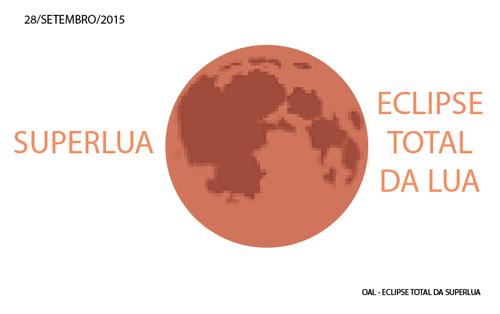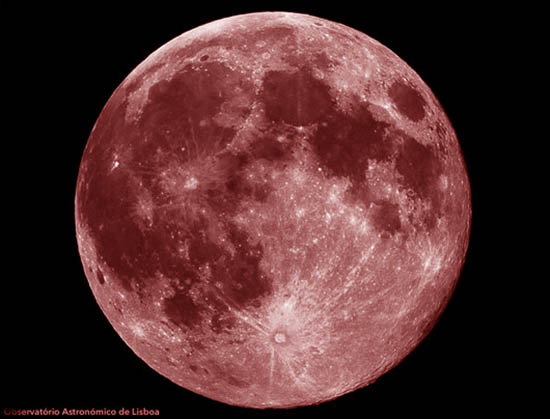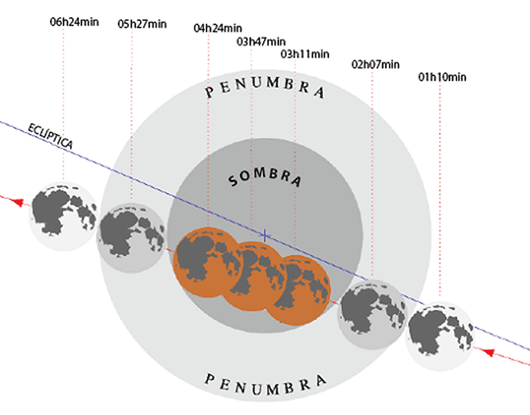 One of the biggest and most anticipated astronomical events of the year, the occurrence of super moon simultaneously with a Total Eclipse of the Moon, it will happen in the early hours of this Sunday to Monday, September 28th.
One of the biggest and most anticipated astronomical events of the year, the occurrence of super moon simultaneously with a Total Eclipse of the Moon, it will happen in the early hours of this Sunday to Monday, September 28th.
According to the Lisbon Astronomical Observatory, this is a phenomenon that has not happened for more than 30 years, the last one having occurred in 1982, and there were only five in the XNUMXth century. The next one will only be in 2033.
And what will happen shortly after midnight? Will the moon go out of sight? Will people all over the world see a giant red moon? What will the moon look like at sunrise? And what relationship does the eclipse have with Jewish festivities?
Shortly after midnight, a set of special astronomical phenomena takes place. The moon enters the Earth's penumbra at 1:10 am and, from that moment on, the moon progressively darkens, acquiring grayer tones.
Then, at 2:07 am, the moon enters the Earth's shadow, starting to get more reddish and brownish tones.
 At 2:46 am, the moon will be in the perigee of its orbit (which will be the shortest in 2015), at a distance of 356877 kilometers from Earth (about 49600 kilometers closer than when it is at its apogee). This proximity makes the moon appear 14% larger in the sky than when the full moon occurs at apogee.
At 2:46 am, the moon will be in the perigee of its orbit (which will be the shortest in 2015), at a distance of 356877 kilometers from Earth (about 49600 kilometers closer than when it is at its apogee). This proximity makes the moon appear 14% larger in the sky than when the full moon occurs at apogee.
The onset of the total eclipse occurs at 3:11 am, when the moon fully enters the Earth's shadow cone.
Although it is completely in shadow, the moon is still visible, but has a reddish and brownish color. In fact, during a lunar eclipse, the sun's rays hit the moon after crossing the Earth's atmosphere where they are dispersed and lose a large amount of blue and green light (they are more trapped in the atmosphere). Thus, during the eclipse, the moon is not lit with white light, but with more reddish light.
The eclipse peak occurs at 3:47 am and, after three minutes, at 3:50 am, the time of the Full Moon phase occurs.
As the Full Moon instant occurs close to that of the perigee, then there will be a super moon, which simultaneously coincides with the height of the eclipse maximum, that is, it will be an eclipse of the super moon.
At 4:24 am, the total eclipse ends and progressively the moon will come out of the shadow, losing its reddish tone and gaining a dark gray tone, and finally at 6:24 am the moon completely leaves the twilight, returning to its usual hue.
The brightness and visibility of the moon
Typically, the super moon is 30% brighter than a regular full moon. Now, this will not happen during an eclipse, in which there is a decrease in luminosity.
The best time to observe the super moon in all its splendor is, as usual, at its birth, which, on the 27th, occurs at 19:10 pm. The super moon will appear on the horizon as a reddish giant moon.
However, the Astronomical Observatory of Lisbon explains that this reddening of the moon is different from what occurs during the eclipse. While, during eclipse, the moon is illuminated by reddish light, during birth/set the moon is illuminated by white light which is later reflected back to Earth and becomes reddish when dispersed in the Earth's atmosphere.
The eclipse will be visible with the same appearance in all places on Earth that, at that moment, have the moon above the horizon.
Thus, the people who will have the opportunity to see this total eclipse of the moon will be those who live in mainland and insular Portugal, in Western Europe, as well as in West Africa, South and Central America, and eastern North America.
In summary, the progression of the eclipse in Portugal (mainland Portugal time) will be as follows:
The moon enters the twilight at …………………… 01:10 am
The moon enters the shadow at ................................02:07
Midway through the eclipse at ....................................03:47
The moon comes out of the shadow at .........................................05:27
The moon comes out of the twilight at .............................06:24
eclipse magnitude = 1,276 considering the moon's diameter as a unit.
Lunar Calendars and Eclipse
 Besides the simultaneity with the super moon, there is yet another curiosity that makes this eclipse a rare event.
Besides the simultaneity with the super moon, there is yet another curiosity that makes this eclipse a rare event.
At least two lunar eclipses occur every year, but only more rarely are these total. It turns out that the last three eclipses were total, this being the last in a tetrada of total eclipses.
On the other hand, the Jewish calendar being lunar and having festival dates defined by the full moon, sometimes the Jewish holidays coincide with tetradas of total eclipses.
This year, as last year in 2014, there is this coincidence and the 4 consecutive total eclipses occur on the days of the Jewish Passover and the Feast of Tabernacles (Sukkot).
This simultaneous occurrence is quite rare and has happened only four times in the last millennium.



















Comments